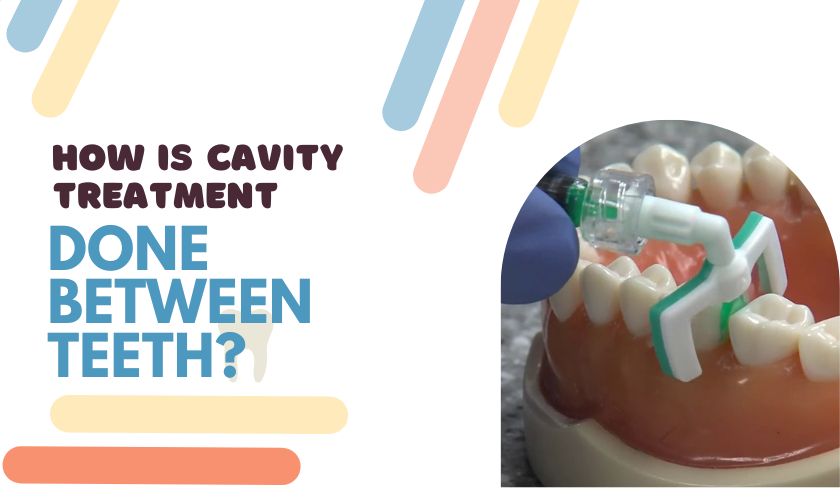Our parents often spoke about cavities when we were kids and used to eat sugar candies. Cavities happen due to a lack of proper oral hygiene. Whenever leftover food is accumulated between the teeth, it rots, and bacteria begin to grow, causing tooth decay. These bacteria harbor in the plaque of the teeth and break down the sugar to produce acid. The acid affects the protective outer layer of the teeth, thus leading to the formation of cavities. A cavity usually located between two teeth, especially the two molars of the teeth, is called an interproximal cavity. This type of cavity takes place due to the wearing away of the enamel.
Signs and symptoms of a cavity between the teeth
The signs and symptoms of cavities may vary considerably based on their extent and location. The primary stages of cavity development may not have any symptoms at all. However, you may start noticing some signs as and when the decay becomes larger. Some of the signs and symptoms include the ones given below.
- Intense toothache or spontaneous pain.
- Sensitivity in the teeth while eating or drinking hot or cold fluids.
- Moderate to sharp pain while eating sweet, hot, or cold food.
- Presence of smaller holes within the teeth.
- Black, brown, or white stains on the tooth surface.
- Pain at the time of biting down on food.
However, cavities may even be noticed before any symptoms occur. It usually happens when you visit a dental office for a regular dental checkup, and the cosmetic dentist near you takes X-rays to find out that you have cavities.
How does a dentist treat cavities?
By consulting a dentist for regular dental checkups, they can identify cavities’ presence before they cause serious dental problems. Once the dentist identifies the presence of cavities, they may recommend you to undergo treatment. Below mentioned are some of the treatment options your dentist may recommend.
Remineralization
Remineralization is considered a natural process of repairing the tooth. When you eat and drink throughout the day, your teeth may lose minerals, known as demineralization. However, factors such as saliva, mouth acid, and mouth bacteria could prevent your body from replacing what it is losing. Remineralization keeps the teeth strong and thus prevents tooth diseases. The remineralization agent plays a crucial role in strengthening the enamel by making it absorb minerals such as calcium and phosphate. The dentist also administers fluoride treatment to bind the enamel and make it more resistant to acid damage.
Filling
Once the dentist removes the decay, a dental filling will be applied to prevent further damage to the tooth and loss of teeth. It also helps in restoring the functionality and aesthetics of the teeth. Fillings are of different types. Some include amalgam fillings, composite fillings etc. Dental fillings are performed as an in-office procedure. A numbing gel is applied onto the gums first; a local anesthetic will be applied to the gum. The decayed portion of the teeth is removed using a drill, and the holes are filled with a dental filling material. Finally, the teeth will be polished and adjusted so that the bite feels normal.
Root Canal
If you feel frequent pain while biting down food, then the chances are that your tooth needs root canal surgery. A cavity, if left untreated, could progress and affect the pulp of the teeth. A tooth at this stage can be considered a badly damaged tooth. A dental root canal treatment is essential to save the badly damaged tooth from extraction. The dentist removes the decay from the teeth’ pulp and damages nerves and tissues. Medications will be put into the root canal to clear any infections. The pulp is thus replaced with a filling that prevents potential infections and dental abscesses.
Crown
Dental crowns are tooth-shaped caps placed over the damaged tooth to prevent the teeth from further infections and improve the teeth’ aesthetics. Same day crowns not only prevent cavities but also protect weak teeth from breaking. It also plays a vital role in restoring worn-down teeth or broken teeth. It also covers teeth with a large filling, a misshapen or discolored tooth, or a tooth that has been treated with root canal therapy.
Extraction
If your tooth has been damaged beyond the point of repair, then the dentist may suggest a same day extraction as the best choice. After administering local anesthesia to numb the area, the dentist extracts the entire tooth, including its root.
Prevention
Some tips for preventing cavities include brushing your teeth with fluoride toothpaste recommended by the dentist at least twice daily. You should also floss regularly and rinse your mouth using a mouthwash. A regular visit to the dentist at least twice a year is also recommended. Above all, ensure that you stick to a healthy diet that strengthens your teeth and gums.
A word from Kelly Dental
We hope you are now aware of what cavities are, the treatment available, and the steps you can undertake to prevent the cavities. It would be best if you always kept in mind the importance of good oral hygiene and its inevitable role in preventing cavities in the future. Therefore make these healthy habits part of your daily routine to keep cavities at bay.

